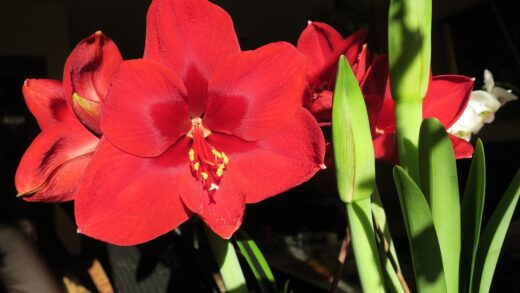The wintering of Jerusalem artichokes is a uniquely flexible process compared to many other garden vegetables, thanks to the remarkable hardiness of the plant’s tubers. These tubers are not only capable of surviving freezing temperatures but actually benefit from the cold, which improves their flavor by converting complex starches into simpler, sweeter sugars. This natural resilience gives the gardener two primary options for winter management: leaving the tubers in the ground for a continuous, harvest-as-needed supply, or harvesting them in the autumn for controlled indoor storage. The choice between these methods depends on your climate, soil conditions, and personal preference for harvesting convenience.
The most common and often easiest method of wintering Jerusalem artichokes is to simply leave them in the garden where they grew. The soil provides excellent insulation, protecting the tubers from the most extreme fluctuations in air temperature and preventing them from dehydrating. This in-situ storage method allows you to harvest fresh tubers throughout the late autumn, winter, and early spring, whenever the ground is not frozen solid. It essentially turns your garden bed into a natural root cellar, providing the freshest possible product on demand and eliminating the need for dedicated storage space indoors.
To successfully winter the tubers in the ground, a few preparatory steps in the autumn are highly recommended. After the first hard frosts have killed the top growth, the tall, dead stalks should be cut down to a height of about 15-20 centimeters. Then, to provide extra insulation and prevent the ground from freezing too deeply, the entire patch should be covered with a thick layer of organic mulch, at least 15-20 centimeters deep. Materials like straw, shredded leaves, or wood chips work perfectly for this purpose. This mulch blanket will make it much easier to dig up the tubers during colder periods.
The alternative strategy is to harvest the bulk of the crop in the late autumn, before the ground freezes hard, and store the tubers indoors. This method provides absolute certainty of access to your harvest, regardless of winter weather conditions, and it is the preferred method for those living in regions with extremely cold winters where the ground can freeze solid for months. It also offers the opportunity to thoroughly clear the bed, which is a key part of managing the plant’s spread and allows for soil amendments to be incorporated before the next season. However, it requires providing the right storage conditions to keep the thin-skinned tubers from drying out.
Understanding tuber hardiness
The remarkable ability of Jerusalem artichoke tubers to withstand winter conditions is rooted in their biological composition. Unlike potatoes, which store their energy primarily as starch, Jerusalem artichokes store their energy in the form of inulin, a type of polysaccharide. This compound, along with other carbohydrates in the tuber, acts as a natural antifreeze, lowering the freezing point of the water within the cells. This prevents the formation of large, damaging ice crystals that would otherwise rupture the cell walls and turn the tuber into a mushy, unusable mass upon thawing. This adaptation allows the tubers to survive being frozen solid in the ground and remain viable for regrowth in the spring.
More articles on this topic
Furthermore, the cold temperatures of winter play a crucial role in improving the culinary quality of the tubers. The exposure to frost and prolonged cold triggers an enzymatic process within the tuber that gradually breaks down the complex inulin molecules into fructose, a simple sugar. This is why tubers harvested later in the winter or in the early spring often have a noticeably sweeter, less starchy, and more refined flavor than those harvested in early autumn before the first frosts. This natural sweetening process is a key reason why many experienced growers prefer to delay their main harvest until after the weather has turned cold.
The tuber’s physical structure also contributes to its winter hardiness. While the skin is thin compared to a potato, it still provides a protective barrier against the soil environment. When left undisturbed in the ground, the tubers are insulated by the surrounding soil, which maintains a much more stable temperature than the fluctuating ambient air. The soil shields them from the most extreme cold snaps and from drying winds, creating a perfect microclimate for preservation. This is why in-ground wintering is so effective; it leverages the natural, stable environment that the tuber is perfectly adapted to.
It is this inherent hardiness that makes the Jerusalem artichoke such a reliable and self-perpetuating crop. The fact that any missed tubers will effortlessly survive the winter to sprout in the spring means the patch will regenerate itself without any intervention. This survival mechanism is the very reason the plant can be considered invasive, but for the gardener who understands it, it is a valuable trait that guarantees a future crop. The plant’s wintering strategy is not one of delicate dormancy, but of rugged, built-in resilience.
In-ground overwintering techniques
Overwintering Jerusalem artichoke tubers directly in the garden soil is the preferred method for many gardeners due to its simplicity and effectiveness. The first step in this process takes place in late autumn, typically after the first one or two hard frosts have caused the plant’s foliage to die back completely. At this point, the tall, brittle stalks should be cut down. Using loppers or sturdy shears, trim the stalks to a height of about 10 to 15 centimeters above the ground. Leaving these short stubs serves as a convenient marker, showing you exactly where the main clumps of tubers are located when you come back to harvest during the winter.
More articles on this topic
The most critical step for successful in-ground wintering, especially in colder climates, is to apply a thick layer of insulating mulch over the entire bed. After cutting the stalks, cover the patch with at least 15 to 20 centimeters of a light, airy organic material. Straw is an ideal choice, but shredded leaves, pine needles, or even spoiled hay will also work very well. This layer of mulch acts like a blanket, trapping geothermal heat and preventing the frost from penetrating deep into the soil. This keeps the ground from freezing solid, or at least keeps it much softer, making it possible to dig and harvest the tubers even in the middle of winter.
Throughout the winter, you can harvest from the patch as needed. Simply pull back a section of the mulch, use a garden fork to gently lift the soil and retrieve the tubers you want, and then carefully replace the soil and the mulch blanket to protect the remaining crop. This on-demand harvesting ensures you are always using the freshest possible tubers, which have a superior texture and flavor. It also solves the primary challenge of Jerusalem artichoke storage, which is their tendency to shrivel and lose moisture once removed from the soil.
It is important to note that while this method is excellent for preserving the harvest, it also guarantees that you will miss some tubers, which will then sprout vigorously in the spring. Therefore, this technique is best suited for a dedicated, permanent patch where the plant is intended to return year after year. If your goal is to completely clear an area or rotate your crops, a full autumn harvest with indoor storage is the better option. For most gardeners, however, the convenience and quality offered by in-ground wintering make it the superior choice.
Harvesting and indoor storage
For gardeners in regions with severe winters where the ground freezes deeply for extended periods, or for those who wish to have complete control over the plant’s location next season, harvesting the tubers for indoor storage is the most practical approach. The ideal time for this main harvest is in late autumn, after the first frosts have improved the tubers’ flavor but before the ground becomes frozen and impossible to work. After cutting down the dead stalks, use a garden fork to carefully dig up the entire crop, being as thorough as possible to minimize the number of volunteer plants that will appear in the spring.
Once the tubers are out of the ground, the preparation for storage is minimal but important. Unlike potatoes, Jerusalem artichokes should not be cured or left to dry. Their thin skin makes them highly susceptible to dehydration. The goal is to get them into a suitable storage environment as quickly as possible. Gently brush off the loose soil, but do not wash the tubers until you are ready to use them, as the thin layer of soil can help to retain moisture. Be sure to inspect the tubers and set aside any that are damaged, soft, or show signs of disease, as these will not store well and can cause the rest of the batch to spoil.
The key to successfully storing Jerusalem artichokes indoors is to replicate the conditions they would experience in the soil: cool temperatures and high humidity. An old-fashioned root cellar is the ideal environment, but a cool, unheated basement, garage, or shed where temperatures remain consistently cold but just above freezing (around 1-4°C) will also work. To provide the necessary humidity and prevent the tubers from shriveling, they should be packed in a suitable medium within a container. A wooden crate, a bucket, or a cardboard box can be used for this purpose.
Place a layer of a damp (but not wet) medium, such as sand, peat moss, or sawdust, in the bottom of your chosen container. Arrange a single layer of tubers on top, ensuring they are not touching each other. Then, cover them completely with another layer of the damp medium. Continue layering the tubers and the medium until the container is full. This packing method keeps the tubers hydrated and in the dark, preserving their firm texture for several months. For smaller quantities, an alternative is to place the tubers in a perforated plastic bag in the crisper drawer of your refrigerator, where they will typically last for a few weeks.
Preparing the patch for spring
Whether you choose to overwinter your Jerusalem artichoke tubers in the ground or harvest them for indoor storage, preparing the patch in late winter or early spring is an important step for the upcoming season. If you have left the tubers in the ground under a layer of mulch, the primary task is to manage the mulch as the weather warms. In early spring, once the threat of deep freezes has passed, you should rake back the thick layer of mulch. This allows the sunlight to reach the soil and warm it up, which encourages the overwintered tubers to break dormancy and begin sprouting.
This is also the perfect time to replenish the soil’s nutrients in preparation for another season of heavy feeding. Before the new shoots become too large, spread a generous layer of well-rotted compost or aged manure over the entire surface of the bed. This top-dressing will provide a slow-release source of essential nutrients that will be carried down into the root zone by spring rains. This annual feeding is crucial for maintaining the long-term health and productivity of a permanent Jerusalem artichoke patch, ensuring that the soil does not become depleted over time.
For those who have harvested the entire crop and are starting fresh, the preparation involves getting the bed ready for replanting. This is an excellent opportunity to incorporate soil amendments and to redefine the borders of the patch or install a root barrier if you haven’t already. Till or fork the soil to loosen it, breaking up any compaction that occurred during the previous season. This is when you would work in your compost or other organic fertilizers, creating a rich and friable bed for the new tubers.
Regardless of your overwintering method, the arrival of spring will bring the emergence of new shoots. This is the time for management and thinning. To avoid an overcrowded patch, which leads to smaller tubers, selectively remove some of the shoots to achieve a final spacing of about 30-45 centimeters between plants. This thinning ensures that the remaining plants have adequate space, light, and resources to grow strong and produce a bountiful harvest. This final step sets the stage for a successful and manageable growing season ahead.


















